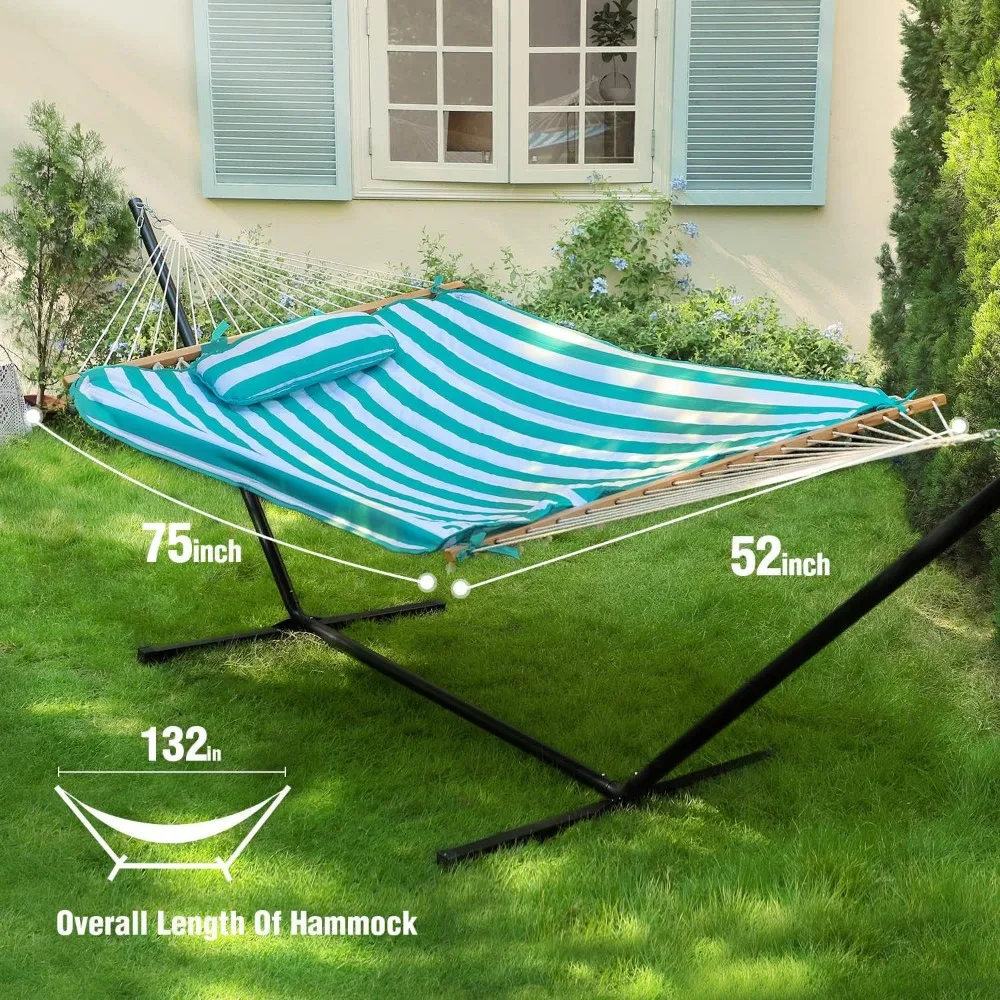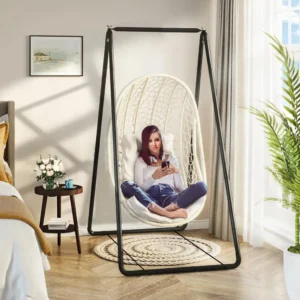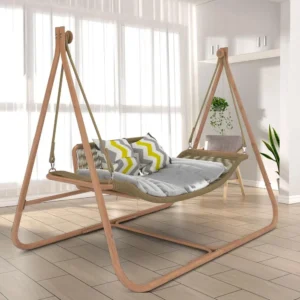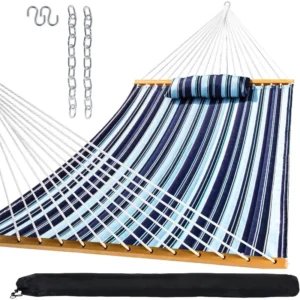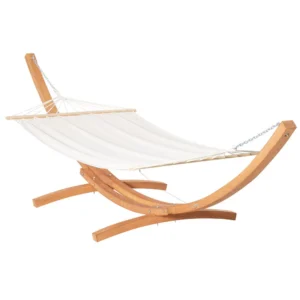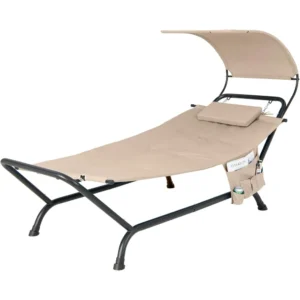Introduction
The gentle sway of a hammock isn’t just for beach vacations or backyard lounging anymore. Indoor hammocks have become increasingly popular as people discover the benefits of bringing this relaxation staple inside their homes. More than just a piece of fabric suspended between two points, an indoor hammock represents a personal retreat – a sanctuary where you can escape the daily grind without ever leaving home.
Indoor hammocks serve dual purposes as both functional furniture and striking design elements. They can transform an ordinary room into a unique space that invites relaxation and contemplation. Whether you’re looking to maximize space in a small apartment or add an unexpected touch to a larger home, indoor hammocks offer versatile solutions that blend comfort with style.
In this guide, we’ll explore the best locations for your indoor hammock, essential installation considerations, and safety tips to ensure your new relaxation spot becomes a beloved feature of your home. Understanding different indoor versus outdoor hammock placement options will help you make the most of your living space.
Why an Indoor Hammock is Worth Considering
Adding a hammock to your indoor space offers benefits that extend far beyond simple decoration. Here’s why you might want to consider this unique addition to your home:
Improved Well-being: The gentle rocking motion of a hammock has been linked to deeper relaxation, better sleep quality, and reduced stress levels. The subtle swaying mimics the comforting sensation we experienced as infants.
Space Efficiency: Unlike bulky sofas or armchairs, hammocks can be easily installed in smaller spaces and even taken down when not in use, making them ideal for apartments or multi-purpose rooms.
Unique Aesthetic Appeal: A well-placed hammock adds character and a sense of adventure to any room. It creates a distinctive focal point that reflects a laid-back, thoughtful approach to home design.
Versatility: From reading and napping to meditation and casual seating, hammocks accommodate various activities while adding a touch of whimsy to everyday routines.
Eco-Friendly Option: Most hammocks use less material than traditional furniture pieces, making them a more environmentally conscious choice for the sustainability-minded homeowner.
Before diving into installation, you’ll want to familiarize yourself with the necessary hammock installation requirements and safety guidelines to ensure your new relaxation spot is both comfortable and secure.
Essential Pre-Installation Considerations
Before mounting your hammock indoors, several important factors require your attention to ensure both safety and optimal enjoyment.
Structural Support Requirements
The most critical consideration is finding appropriate structural supports within your walls or ceiling:
- Load-bearing walls: Locate wall studs using a stud finder. Wood studs typically provide sufficient support for most hammocks.
- Ceiling joists: For ceiling mounts, identify solid wooden joists, not just drywall or decorative elements.
- Avoid mounting into: Metal studs, hollow doors, drywall alone, or decorative molding.
Weight Capacity Planning
- Match hammock weight rating with hardware capacity
- Standard hammocks typically support 250-450 pounds (113-204 kg)
- Hardware should exceed the combined weight of users and the hammock itself
- Quality 3/8-inch eye bolts typically support 300-400 pounds (136-181 kg)
Space Requirements
A typical indoor hammock installation requires:
– Minimum length: 13 feet × 5 feet (4 meters × 1.5 meters) for standard hammocks
– Chair hammocks: 3-4 feet (0.9-1.2 meters) of radial clearance
– Height consideration: Anchor points should be approximately 4-6 feet (1.2-1.8 meters) from the floor
Hammock Style Considerations
Different hammock styles have varying installation requirements:
– Brazilian hammocks: Need significant length and a pronounced curve
– Spreader bar hammocks: Require less distance but more height
– Chair hammocks: Need only a single overhead anchor point but must clear the floor adequately
The flow of your room and accessibility around the hammock should also factor into your placement decision. Consider how the hammock will affect movement through the space when both in use and not in use.
For those with concerns about permanent installation, exploring whether indoor hammock installation is safe for your specific situation can provide peace of mind. If structural challenges arise, our collection of hammock chairs with stands offers excellent alternatives that don’t require mounting.
Best Places to Hang a Hammock Indoors
Living Room: Creating a Relaxation Focal Point
The living room offers an ideal setting for an indoor hammock, transforming your main gathering space into a conversation piece that invites relaxation. A strategically placed hammock can become the favorite spot for family members and guests alike.
To integrate a hammock into your living room:
- Position it in a corner to create a dedicated reading nook
- Install it as a room divider to subtly separate functional areas
- Place it near natural light sources for daytime enjoyment
- Consider sight lines to entertainment centers if you’ll use it for TV watching
The social aspect of a living room hammock makes it particularly appealing – it creates an inviting spot for casual conversation while adding visual interest to the space. Choose a hammock style that complements your existing décor, whether that’s a colorful woven design for boho spaces or a clean, minimalist option for contemporary rooms.
For living room corners where space might be limited, swinging hammock chair sets provide a compact alternative that delivers the same relaxation benefits.
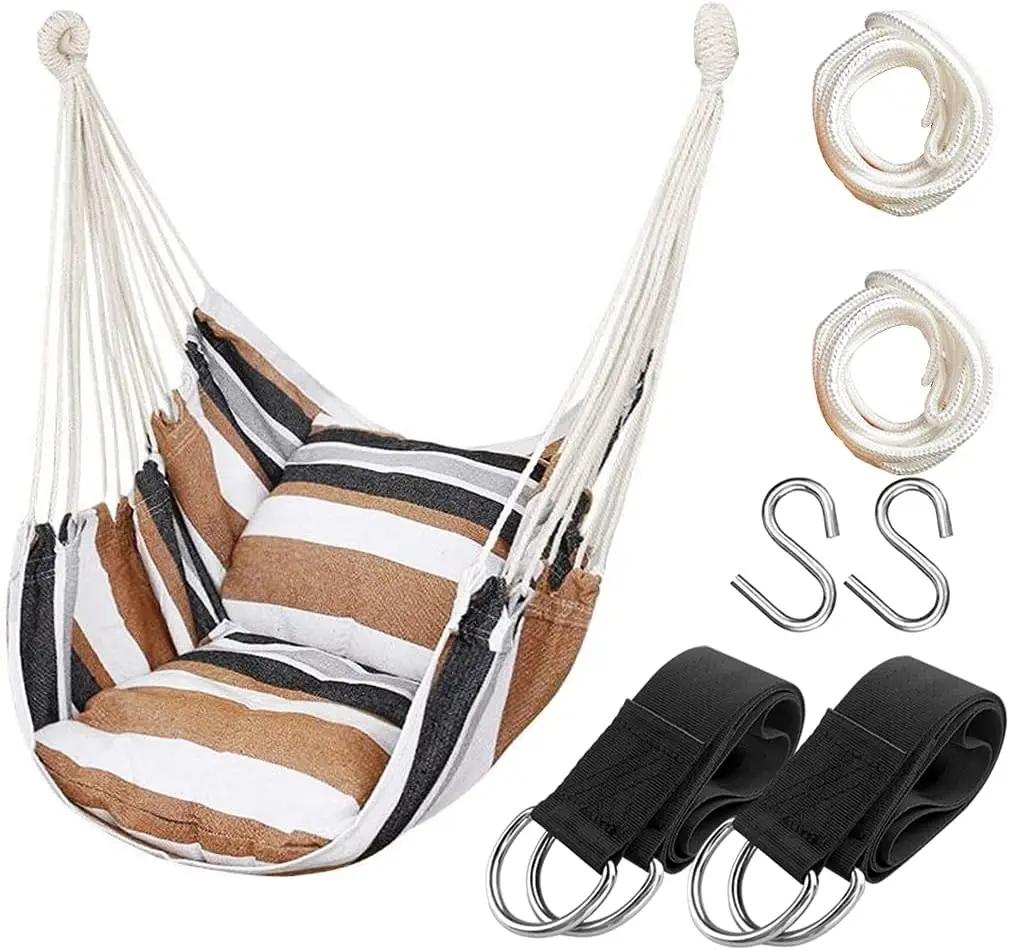
Bedroom: Creating Your Personal Relaxation Sanctuary
Your bedroom can be transformed into an even more peaceful retreat with the addition of a hammock. This private space allows for uninterrupted relaxation and can significantly enhance your sleep environment.
Perfect bedroom hammock placements include:
- Near a window to create a sunny morning relaxation spot
- In a reading corner with good lighting
- At the foot of the bed as an alternative lounging option
- Along a wall, replacing a traditional chair or chaise lounge
Bedroom hammocks excel at creating a personal sanctuary where you can decompress after a long day. They’re particularly well-suited for meditation, reading, or simply enjoying quiet contemplation. Some people even prefer sleeping in Brazilian-style hammocks rather than traditional beds, citing improved sleep quality.
For master bedrooms or spaces meant for couples, our double hammock sets offer enough room for shared relaxation while maintaining the intimate feel of your bedroom retreat.
Sunroom or Enclosed Porch: Bringing the Outdoors In
Sunrooms and enclosed porches represent the perfect marriage between indoor comfort and outdoor ambiance, making them ideal locations for hammock installation. These spaces typically feature:
- Abundant natural light that enhances the hammock experience
- Stronger structural elements due to their transitional nature
- Year-round usability regardless of weather conditions
- The perfect backdrop for creating a resort-like atmosphere at home
In these settings, your hammock becomes the centerpiece of a personal retreat where you can enjoy the feeling of being outdoors while remaining protected from insects, rain, and temperature extremes. The connection to nature through large windows enhances relaxation while maintaining comfort.
To maximize the outdoor feel:
– Position the hammock to capture the best views
– Surround it with potted plants for a lush environment
– Use weather-resistant hammock materials if the area receives significant sun exposure
For maximum comfort in these light-filled spaces, deep seat hammock chairs provide excellent support while allowing you to fully enjoy the surrounding views.
Home Office: The Productive Break Zone
Incorporating a hammock into your home office may seem unconventional, but it can significantly enhance your work experience and productivity. A well-placed office hammock serves multiple purposes:
- Creates a dedicated space for short mental refreshment breaks
- Provides a change of posture and position during long work days
- Offers an alternative thinking space for creative problem-solving
- Helps maintain work-life balance within the same room
Research consistently shows that short breaks improve focus and creativity. Having a hammock nearby allows you to physically step away from your desk while remaining in your workspace, creating mental separation that helps reset your thinking.
For smaller home offices, compact chair hammocks can be installed in corners or near windows without dominating the available space. Position your hammock far enough from your desk to create psychological distance but close enough for convenient access during short breaks.
For additional ideas that work well in multi-purpose spaces, explore our guide to ideal hammock locations for both work and relaxation environments.
Children’s Room: Fun and Functional Space
A hammock in a child’s room can be both a playful addition and a practical relaxation zone. Children are naturally drawn to the swinging motion and enclosed feeling of hammocks, making them popular features in kids’ spaces.
When installing a hammock in a child’s room, consider:
- Mounting it lower to the ground for easier and safer access
- Choosing models with lower weight capacities specifically designed for children
- Creating a reading nook with books and soft lighting nearby
- Incorporating the hammock into the room’s play theme or design
Beyond just being fun, hammocks can benefit children’s development by providing gentle vestibular stimulation, which supports sensory integration. They can also create cozy retreats for children who need quiet time or a sense of security.
Safety is paramount in children’s rooms, so ensure all hardware is securely installed, teach proper entry and exit techniques, and always supervise younger children during use.
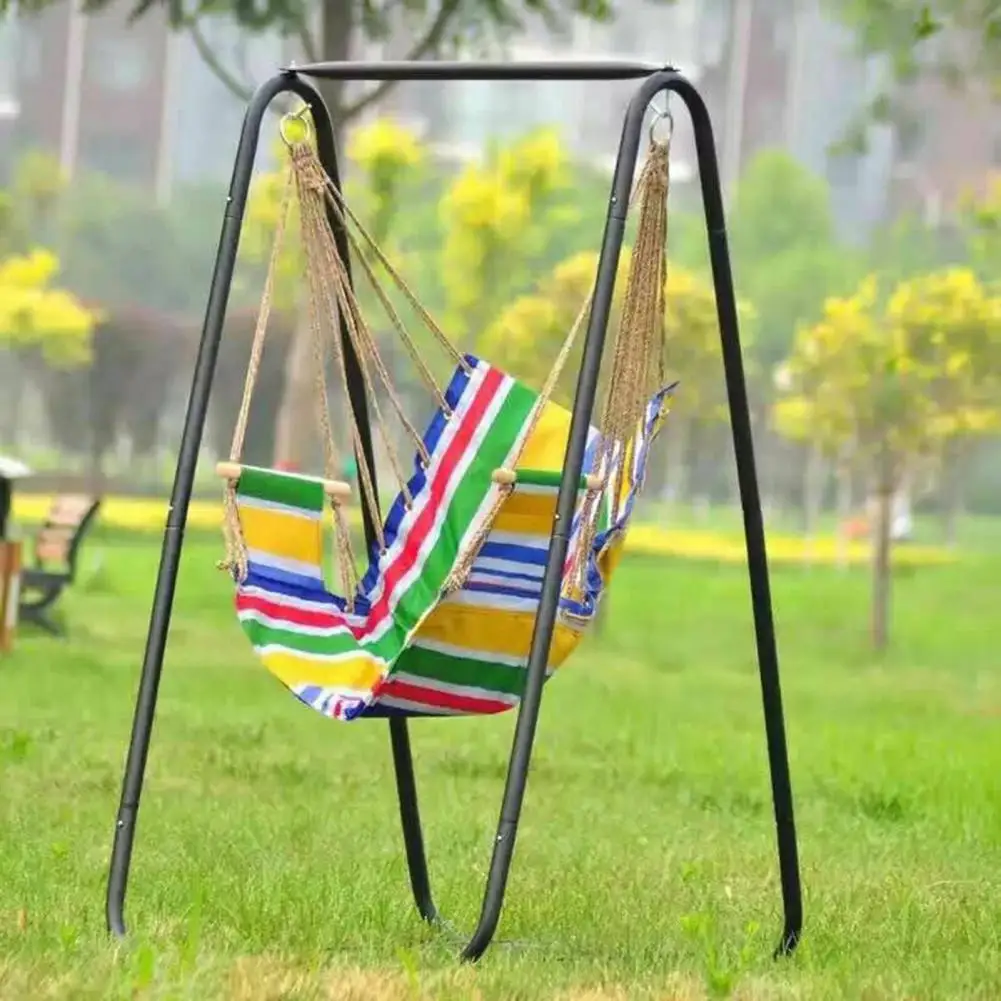
Underutilized Corners: Maximizing Dead Space
Those awkward corners and unused spaces in your home can be transformed into cozy retreats with the strategic placement of a hammock. This approach is particularly valuable in:
- Apartment living where every square foot counts
- Open floor plans with undefined corner areas
- Transition spaces between rooms
- Areas under stairs or in alcoves
L-shaped or diagonal hammock installations can turn these “dead zones” into the most inviting spots in your home. By anchoring to walls that meet at angles, you can create a suspended nook that requires minimal floor space.
For successful corner installations:
– Measure the available space carefully, accounting for the hammock’s arc
– Consider the distance between mounting points (typically 10-12 feet or 3-3.7 meters for full hammocks)
– Ensure both anchor points connect to solid structural elements
– Account for the occupied space when the hammock is in use
When full-sized hammocks won’t fit, hanging egg chair sets offer excellent alternatives that require less clearance while still providing the enjoyable swinging sensation.
Near Large Windows: Enjoying the View
Installing a hammock near large windows creates a perfect spot for contemplation while enjoying natural views. This placement:
- Maximizes natural light for reading and relaxation
- Creates a connection with outdoor spaces and nature
- Provides changing scenery throughout the day
- Makes even small rooms feel more spacious
The combination of gentle swaying and visual connection to the outdoors enhances the relaxation experience, making window-adjacent hammocks particularly effective for stress reduction and mindfulness practices.
When installing near windows, consider:
– Privacy factors if windows face public areas
– Temperature fluctuations (windows can be drafty or hot)
– UV exposure that might fade certain hammock materials
– Positioning to capitalize on the best views
Window treatments like sheer curtains can provide privacy while maintaining the light and view benefits that make this placement so appealing.
How to Securely Hang an Indoor Hammock
Required Tools and Hardware
Creating a safe indoor hammock setup requires specific tools and hardware:
Essential Tools:
– Stud finder (electronic preferred)
– Drill with appropriate bits for your wall type
– Measuring tape
– Level
– Pencil for marking
– Wrench for tightening hardware
Required Hardware:
– Heavy-duty eye bolts (minimum 3/8-inch or 10mm diameter)
– Mounting plates for additional support if needed
– Carabiners rated for at least 300 pounds (136 kg)
– S-hooks or chains for height adjustment
– Wall anchors appropriate for your specific wall type (if not mounting into studs)
Quality Considerations:
– Look for hardware with clear weight ratings
– Choose stainless steel components to prevent rusting
– Verify that carabiners have locking mechanisms
– Select hardware rated for at least 1.5 times your intended weight limit
Optional accessories like spring links or rope ratchets can make tension adjustments easier once your hammock is installed. Proper hammock placement guidance can help ensure your setup is both safe and comfortable.
Step-by-Step Installation Guide
Follow these steps for a secure indoor hammock installation:
Locate and Mark Anchor Points
– Use a stud finder to locate wall studs or ceiling joists
– Mark the center of these structural supports
– Ensure anchor points are 2-3 feet (60-90 cm) longer than your hammock’s total length
– Typical height for wall anchors: 4-6 feet (1.2-1.8 meters) from the floorDetermine Ideal Height and Distance
– For typical adult use, anchors should be 4-5 feet (1.2-1.5 meters) high
– Distance formula: Hammock length plus 1-2 feet (30-60 cm)
– Use a tape measure to verify clearance from furniture and walls
– Mark final positions with a pencilDrill Pilot Holes
– Use a drill bit slightly smaller than your eye bolt shaft
– Drill straight into the center of the stud/joist
– For wood studs: 1/8-inch or 3mm pilot hole for 3/8-inch hardware
– Ensure holes are perfectly horizontal or vertical depending on mount typeInstall Hardware
– Screw eye bolts into pilot holes until the eye is flush with the wall
– Tighten securely using a screwdriver or wrench through the eye for leverage
– Install any chains, S-hooks, or extenders needed for adjustment
– Verify all hardware is fully securedMount and Test Your Hammock
– Attach hammock ends to the installed hardware using carabiners
– Adjust height and tension for optimal comfort
– Gradually test weight capacity before full use
For optimal results, have a helper assist with measurements and final installation. This ensures proper alignment and makes the process considerably easier.
Safety Testing Your Installation
Before fully enjoying your indoor hammock, thoroughly test your installation with this safety checklist:
Gradual Weight Testing
– Apply gentle pressure first
– Sit carefully in the center without fully reclining
– Gradually increase to full body weight
– Listen for any concerning sounds from anchor pointsWarning Signs to Watch For
– Creaking or popping sounds
– Visible movement of hardware
– Drywall cracking around mounting points
– Any feeling of give or sinking at the anchor pointsOngoing Safety Maintenance
– Inspect all hardware monthly
– Check for signs of wear on the hammock body
– Re-tighten any loose components immediately
– Verify weight distribution remains evenWhen to Reinstall or Strengthen
– If any movement is detected at anchor points
– After structural changes to the home
– If hardware shows any signs of bending or stress
– When changing to a heavier hammock type
Never exceed the weight rating of your hammock or hardware, and always prioritize safety over convenience when choosing mounting locations. For comprehensive guidance, our hammock safety guide provides additional information for both indoor and outdoor installations.
Enhancing Your Indoor Hammock Experience
Once your hammock is securely installed, these additions can transform it into the ultimate relaxation zone:
- Comfort Accessories
- Throw pillows in varying sizes for head and back support
- Lightweight blankets for cooler seasons
Memory foam bolsters for extended lounging comfort
Practical Additions
- C-shaped side tables that slide under the hammock for books or drinks
- Clip-on reading lights for nighttime enjoyment
Small storage baskets nearby for essentials
Ambient Elements
- String lights or dimmable lamps for evening ambiance
- Plants positioned nearby to create a natural setting
Essential oil diffusers for aromatic relaxation
Seasonal Adaptations
- Lightweight cotton accessories for summer
- Heavier textiles and throws for winter comfort
- Changing pillow covers to reflect seasonal colors
Creating a complete relaxation zone might include a small bookshelf within arm’s reach, a dedicated speaker for music or meditation tracks, or even a custom canopy for added privacy and coziness.

Dark Wood Hammock Sets, Porch Swing Chair Sets
$653.82 Select options This product has multiple variants. The options may be chosen on the product pageA-Frame Stand Hammock Sets, Swinging Hammock Chair Sets
$154.62 Select options This product has multiple variants. The options may be chosen on the product pageLight Wood Hammock Sets, Swinging Hammock Chair Sets
$1,359.35 Select options This product has multiple variants. The options may be chosen on the product pageClassic Wooden Stand Hammock Sets, Heavy Duty Hammock Sets
$1,061.68 Select options This product has multiple variants. The options may be chosen on the product pageHammock Sets with Canopy, Heavy Duty Hammock Sets
$286.31 Select options This product has multiple variants. The options may be chosen on the product page
Alternative Mounting Options for Renters and Beyond
If drilling into walls isn’t an option, several alternatives can bring the hammock experience into your home:
Hammock Stands
Pros:
– No wall or ceiling modifications needed
– Portable and repositionable
– Available in various materials and styles
– Some models fold for storage
Cons:
– Require floor space (typically 9-15 feet × 4 feet or 2.7-4.6 meters × 1.2 meters)
– Generally more expensive than simple mounting hardware
– Some assembly required
– May not provide the same feeling as wall-mounted options
Doorway Bar Mounts
Pros:
– Minimal or no permanent modification
– Work well in apartments and rental homes
– Easy to install and remove
– Compact solution for smaller spaces
Cons:
– Limited to doorway width
– May interfere with door function
– Lower weight capacity than wall mounts
– Not suitable for all hammock types
Tension Rod Systems
Pros:
– No drilling required
– Adjustable to various spaces
– Can be installed in window frames or alcoves
– Relatively inexpensive
Cons:
– Lower weight capacity
– Require specific architectural features
– May leave pressure marks on surfaces
– Better suited for lightweight hammock chairs than full hammocks
For renters or those frequently changing homes, selecting appropriate materials for portable hammock options can ensure both comfort and practicality. Our collection of hammock and stand sets offers excellent solutions that require no permanent installation.
Essential Safety Tips for Indoor Hammocks
Follow these critical safety guidelines to ensure worry-free enjoyment of your indoor hammock:
Respect Weight Limits
Never exceed the rated capacity of your hammock or mounting hardware, even temporarily. Remember that dynamic movement adds strain beyond static weight.Maintain Regular Inspections
Check all hardware, mounting points, and the hammock body monthly for signs of wear, fraying, or loosening.Practice Child and Pet Safety
Never leave young children unattended in hammocks. Consider height and access when pets are present to prevent entanglement or falls.Master Proper Entry and Exit
Enter slowly from the side while stabilizing the hammock with one hand. Distribute weight gradually to prevent tipping.Prevent Common Hazards
Keep hammocks away from heat sources, sharp objects, and areas with high foot traffic. Ensure sufficient clearance from walls when the hammock is in full swing.Check for Wear Patterns
Pay special attention to connection points and areas of friction, replacing components before they fail.Install Emergency Support
Consider secondary safety straps for critical installations, especially when the hammock is hung at greater heights.
Careful attention to these safety considerations will ensure your indoor hammock remains a source of joy rather than concern.
Frequently Asked Questions About Indoor Hammocks
How much space do I need for a standard indoor hammock?
Most indoor hammocks require 13-15 feet (4-4.6 meters) of linear space and about 5 feet (1.5 meters) of width. Hammock chairs need about 4 feet (1.2 meters) of radial space.
Can I hang a hammock from drywall?
No, drywall alone cannot support the weight of a hammock and occupant. Always mount into wall studs, ceiling joists, or use a free-standing hammock stand.
What’s the best height for hanging an indoor hammock?
For most adults, wall anchors should be 4-5 feet (1.2-1.5 meters) from the floor, with the hammock hanging approximately 18-24 inches (45-60 cm) from the floor when weighted.
Can I hang a hammock in an apartment without damaging walls?
Yes, options include using a hammock stand, door frame mounts, or tension rods. Always check your lease agreement regarding temporary modifications.
How do I find studs in older houses with irregular framing?
Use an electronic stud finder with deep scanning capabilities, or try the “knock test” to identify hollow versus solid areas. When in doubt, consult a professional.
Is it safe to sleep overnight in an indoor hammock?
Yes, when properly installed, many people find hammocks comfortable for overnight sleeping. Brazilian-style hammocks without spreader bars are typically best for sleeping.
How do I clean my indoor hammock?
Most fabric hammocks can be machine washed in cold water and air-dried. Remove any hardware before washing and follow manufacturer-specific care instructions.
Is an Indoor Hammock Right for Your Living Space?
After exploring the many possibilities for indoor hammock placement, the question remains: is this unique addition right for your home? Consider these final reflections:
An indoor hammock offers a distinctive combination of practical benefits and aesthetic appeal that few furniture pieces can match. The gentle swaying motion provides physiological relaxation that can transform your everyday experience at home, while the visual appeal adds character to your space.
Ask yourself:
– Do you have appropriate structural support or space for alternatives?
– Will a hammock complement your existing interior design?
– Do you value versatility and space efficiency in your furniture?
– Are you looking for a unique relaxation experience within your home?
The beauty of indoor hammocks lies in their adaptability. Whether you choose a full traditional hammock spanning your living room, a compact hammock chair in a bedroom corner, or a portable stand for flexibility, there’s likely a configuration that will work for your specific needs.
The indoor hammock represents more than just a place to sit—it’s a statement about prioritizing relaxation and embracing unconventional thinking in home design. With proper installation and thoughtful placement, it can become your favorite spot to unwind, reflect, and enjoy the simple pleasure of gentle relaxation.

